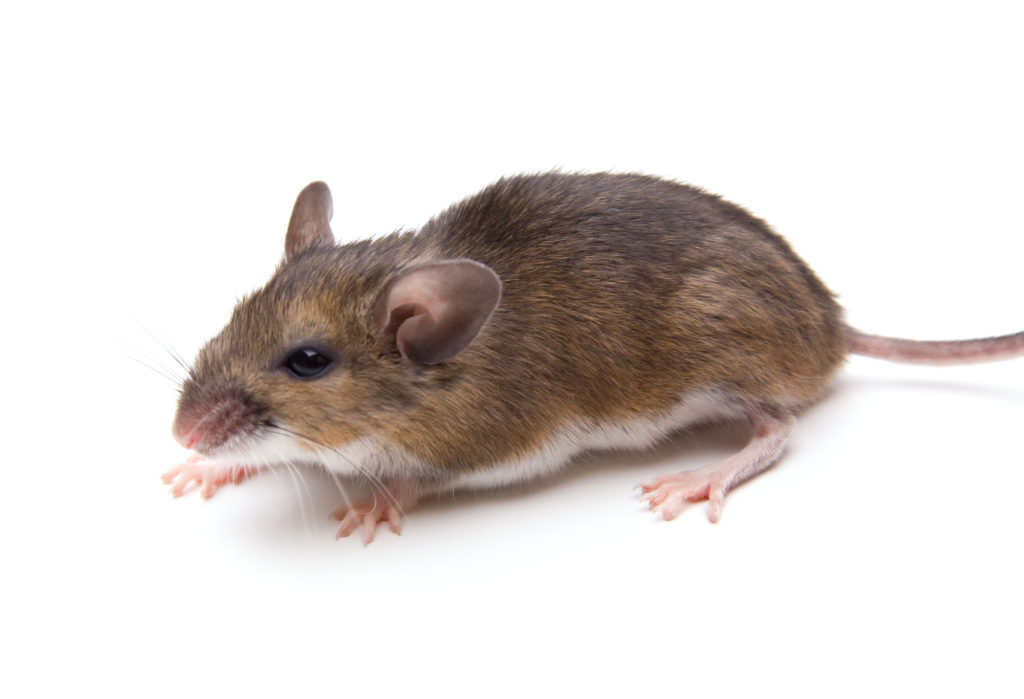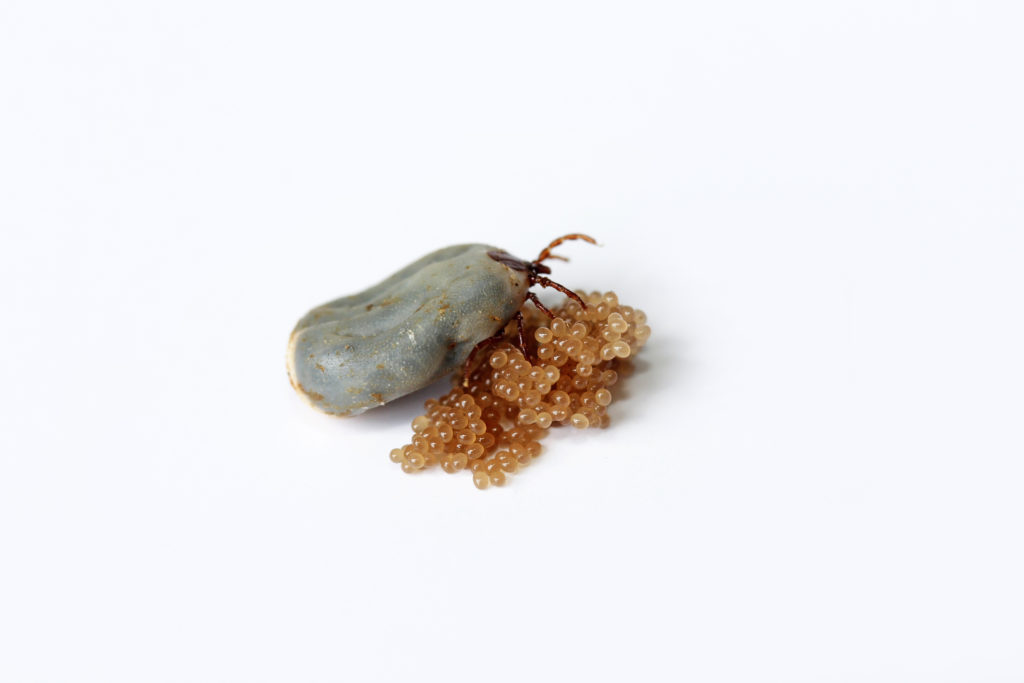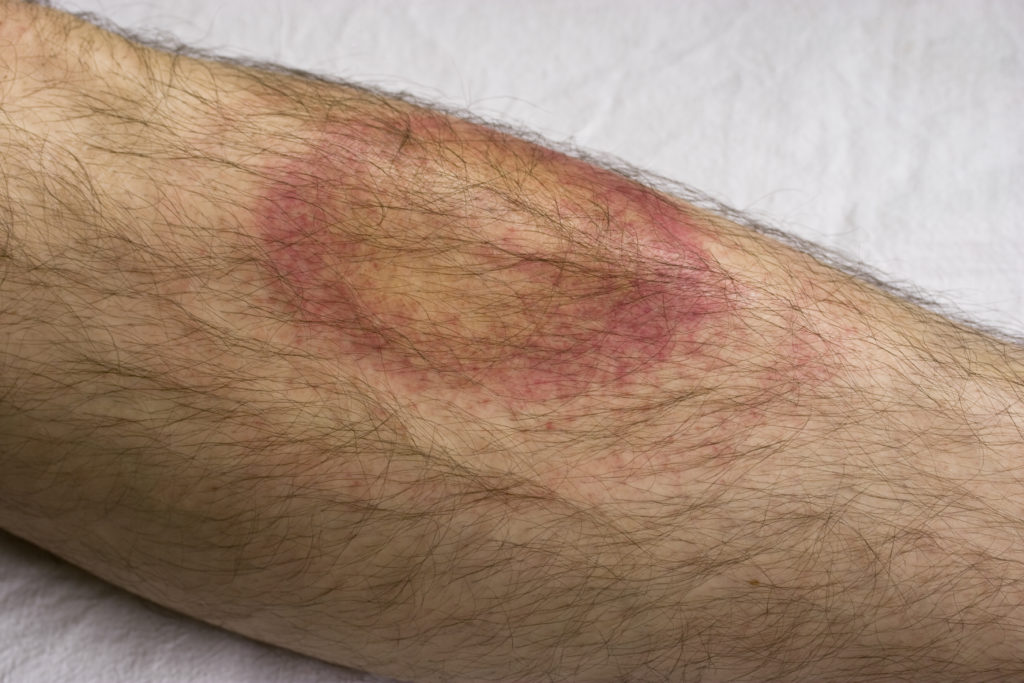It’s a hot humid day and you’ve spent hours walking through the woods, brushing up again shrubs and foliage while scouting sites for opening day. You come inside to change and see a little something on your ankle.
Is it a freckle you didn’t notice before? One that wasn’t there a few hours ago? It looks a little bit like a poppy seed, but it isn’t falling off. The next day it’s still there, so you take a closer look and see that it has eight legs and a head embedded in your skin. This little beast has been feeding on you for a day and you didn’t feel a thing.
BY DR. SARAH ZOHDY, AUBURN UNIVERSITY

While often called “insects,” ticks are actually more closely related to spiders. Insects have six legs and antennae, but ticks have eight legs. They are found all over the globe and feed on almost everything, from small birds to humans. If you have experience with ticks you might have noticed that they come in different sizes, ranging from a grain of sand to a large seed. All different tick species come in multiple sizes, because these sizes represent different life stages of the tick.
READ: MORE RESEARCH FROM THE AUBURN DEER LAB
Ticks start off as eggs, then hatch into larvae, which feed, molt, then turn into nymphs. Nymphs then feed on another host, molt, then turn into adults. Ticks are excellent at causing disease in humans because they not only ingest blood during their three-host, multi-year feeding process, but they also pick up any disease-causing microbes in the blood with each feeding session, adding to their collection of germs as they grow.

By the time a tick feeds on you, it has already built an arsenal of germs from previous hosts that they can spread to you. While most of a tick’s life is solitary, as adults, male and female ticks meet up on a host (often large animals such as deer) and mate. So if you see many ticks clustered together on a deer, you’re witnessing what is essentially a tick nightclub, where adults can find mates. One of the reasons adult females require a large host, such as a deer, is to get the volume of blood necessary to help her thousands of eggs to develop.
LEARN MORE ABOUT DEER RESEARCH FROM AUBURN UNIVERSITY
While females consume this essential blood meal, they may actually double in size, collecting a volume of blood that they could not have acquired from a small animal such as a mouse. Following feeding, females drop off their host to lay their eggs. This entire life cycle takes around two years. The female’s final blood meal is critical for tick populations to grow, therefore deer are a very important component of their life cycle, and having an understanding of deer is essential to understanding tick ecology and tick-borne diseases.
The tick feeding process is quite complicated. Unlike mosquitoes, which prefer fast-food, taking a quick blood meal from wherever they can before you have a chance to shoo them away, ticks prefer fine-dining. Once ticks are embed into your skin they can feed for two to three days straight, so they invest a lot of effort into finding the right host and the right location to feed from. To find the right dining spot, ticks climb up foliage, stand on their back limbs and wave their front limbs in the air. If you look closely at the edges of shrubs and tall grasses while walking through the woods you might see ticks do this strange dance, which is referred to as “questing,” and can look a lot like the inflatable man at a car dealership on a windy day.
Ticks feed on living, breathing creatures, and the best way to find a host that breathes is to detect carbon dioxide (the air we breathe out). Questing ticks have the ability to detect carbon dioxide, heat and odor. As a host brushes past, the tick uses its dangling limbs to climb aboard. Once on the host, the tick begins looking for the perfect place to feed. Ticks are very particular about their dining location so this process can take a very long time, sometimes hours. The ideal location is a place with relatively thin skin which can be easily pierced to extract blood.
Once the tick finds its gourmet dining spot, it burrows its head into the skin, places a feeding tube into a blood vessel, and injects a numbing solution that thins blood and fights off the immune system. Typically with a creature feeding on you, your immune system would trigger a response that causes itching, warming, swelling or other reactions, but by tricking your immune system the tick can feed on you for days without being noticed.
What Does This Mean to Hunters?
Well, if you are a hunter, you probably enjoy the great outdoors, which means you probably have encountered many ticks in your life. Since ticks are really good at spreading diseases and can often bring you multiple disease-causing microbes during one feeding bout, it’s important to know what you can do to prevent tick bites, or find ticks as early as possible.

Ticks often don’t start transmitting disease causing microbes until several hours into their feeding, and since it takes a few hours for ticks to find their fine-dining location, you have a reasonable window of time to find and remove a tick before there is much risk. Doing simple tick checks on your body every few hours is a simple way to prevent tick-borne diseases. Similarly, taking a shower once you come indoors is a great way to remove any hungry roaming ticks before they bite. Don’t forget, sometimes these ticks can be very small and may look like poppy seeds, freckles or flecks of dirt, so check closely or have someone check for you in hard to reach places.
Since ticks grasp onto you from dense vegetation and tall grasses, staying in the middle of a trail when you can is another easy way to prevent ticks from grabbing onto you. Since deer are tick mating grounds, ticks that are responsible for many tick borne diseases in humans are found where deer are. As a result, hunters may be at particularly high risk. So if you are in a habitat that deer would spend a lot of time (bedding locations with dense vegetation are particularly good spots to pick up ticks), be sure to tuck your pants into your shoes or boots (ticks love the thin skin on ankles) and use some form of tick repellent. Typically those that contain DEET are the most effective.
Oil of lemon eucalyptus is another repellent that has been shown to work very well for ticks and mosquitoes. Permethrin embedded clothing or gear might also help keep ticks off. If you are outdoors, wearing light-colored clothing is an easy way to make your tick checks a bit faster, because ticks will contrast the cloth well, making them easy to spot.
What to Do if You Find a Tick?
If you find a tick, but it is already embedded and eating, then best thing to do is to find a pair of tweezers, grab the tick as close to the skin as possible, and gently pull straight up. You do not want to grab the tick by the body, because ticks are full of disease causing microbes and squeezing it might push those microbes into your body through the tick’s mouth parts. You also do not want to just use your fingers and quickly rip the tick out. Doing that will result in its head and mouthpiece remaining in your skin. While that still kills the tick, it might take time for the mouthpiece to come out of your skin and there may be a bit of irritation or potential infection that results from that.
Once you remove an embedded tick from your skin, you can store it in a ziplock bag and throw it in the freezer in case you develop any disease-like symptoms.
Symptoms to Look For When Exposed to Ticks
Most tick borne diseases have similar symptoms that include fever and chills, redness, swelling, muscle aches and pains, vomiting and/or gastrointestinal distress, rash and headaches. If you have any of these symptoms following a tick bite, you should go to the doctor as soon as possible, because some tick borne diseases can only be effectively treated within a few days of infection.

One easy way for your physician to rule out diseases is to know which tick species was on you, so saving and bringing any ticks that were embedded in your skin to the doctor can make a huge difference and can ensure that you receive the best treatment plan as quickly as possible.
MORE: AUBURN DEER RESEARCH FACILITY
What is a Deer Tick?
The deer tick (also referred to as black-legged tick) is the common name for Ixodes scapularis, the tick that is responsible for Lyme disease. This tick thrives in deer habitat and is commonly found on deer. Unlike other vectors of disease such as mosquitoes, which might be strongly affected by seasonality, as long as temperatures are above freezing these ticks will be out.
Deer tick larvae are often very small and found only on small mammals, since they do not require a large blood meal and small terrestrial scurrying creatures are easier to grasp on to. Deer tick nymphs and adults might be found on you, since they require larger blood meals. Nymphs look a lot like poppy seeds. This small size means that these ticks, while one of the most important for tick-borne diseases in humans, might be difficult to find if you don’t know exactly what you’re looking for. Sometimes another creature often found on deer, known as the deer ked, is confused for a tick.
Deer keds are a type of wingless biting fly that also feed on deer blood and can feed on humans as well. Unlike ticks, deer keds are insects with only six legs and they tend to be a bit larger than ticks. Deer keds do not embed their head into skin like ticks. Instead, keds are typically found rapidly scurrying through the hair, and while a deer is down, keds might quickly run onto your arm or boots, moving a bit like crabs. In contrast, ticks remain in one place while they feed for days. While deer keds may also feed on humans and spread microbes, that’s a different topic for a different day.
What is Lyme Disease?
Lyme disease (LD), most common in the Midwest and Northeastern United States, is caused by a bacterium called Borrelia burgdorferi. This bacteria thrives in populations of white-footed mice, so when a larval tick feeds on these mice it fills itself with Lyme disease causing bacteria, which it can carry to its next hosts. In some regions with very degraded forests where white-footed mice are the most prevalent, and therefore questing ticks don’t have many other meal options, nearly a quarter of nymphal deer ticks carry Lyme disease causing bacteria.
Lyme disease is a complicated beast, because it circulates in the blood for a short period of time, but then has the ability to hide out outside of circulating blood, meaning that detection of the bacteria from blood might be unclear or impossible if more than a few days have passed since a tick bite (which is when the symptoms may appear).
Another thing that makes LD difficult to detect is the fact that one of its defining symptoms, erythema migraines (a bull’s-eye rash that radiates out from the location of the tick bite over time) does not appear in all cases. The mystery behind LD and inconsistencies in symptoms has made this a controversial topic. If LD goes untreated, it can often develop into chronic Lyme disease, which can have long term neurological and neuromuscular impacts. So if you develop a rash, but saved the tick you pulled off of yourself, you may be able to identify it as a deer tick or not.
Other Tick Borne Diseases
While ticks are very good at spreading disease causing pathogens, remember that we also have powerful immune systems, so getting an infection does not always mean that the infection will lead to symptoms or disease. However, it is a good idea to become familiar with common tick borne diseases near you. Most patterns of human cases of tick borne diseases align closely with the distribution of the ticks that are responsible for them. For example, ehrlichiosis, a bacterial illness caused by Ehrlichia chafeensis or E. ewingii bacteria is transmitted by lone star ticks (Amblyomma americanum), and therefore most of these reported cases of ehrlichiosis occur in the southeast and south-central United States where lone star ticks are most common.
Another common tick-borne disease is Rocky mountain spotted fever, caused by the bacterium Rickettsia rickettsia and spread by the brown dog tick (Rhipicephalis sanguinus), American dog tick (Dermacentor variabilis), and Rocky mountain wood tick (Dermacentor andersoni). Similar to other tick borne diseases, symptoms include high fever and severe headaches, but one characteristic symptom is the rash that gave this disease its name. Small, red, flat bumps develop on the hands and ankles and migrate upward, eventually reaching the trunk in nearly all cases. Unlike other diseases, babesiosis, is a tick-borne disease caused by a parasite, Babesia microti, that infects red blood cells, like malaria.
MORE: TICKS, FLEAS NOT JUST A SEASONAL PROBLEM
The symptoms of babesiosis are also very similar to malaria in that infected individuals might have very high fevers and chills, anemia, jaundice and fatigue. Babesiosis is also caused by deer ticks, and therefore tends to overlap in range with Lyme disease and anaplasmosis (another bacterial illness transmitted by deer ticks). A few tick-borne viruses, such as Powassan, Heartland and Bourbon viruses were recently discovered in the United States when individuals were treated for bacterial tick-borne diseases with antibiotics, but ended up dying because antibiotics do not treat viruses. Not much is known about these viruses, although Powassan is a flavivirus (like West Nile virus), transmitted by deer ticks and can develop into an encephalitis (brain swelling) if left untreated and undiagnosed.
What Time of Year are You Most Likely to Get a Tick Bite?
Most people get tick bites during summer, because that’s when nymphs are especially active. However, deer ticks are active year round and even very cold temperatures do not inhibit their activity. In order to maximize their success, breeding of adult deer ticks tends to coincide with deer breeding (lots of nightclubs to meet potential mates), so it’s important to be particularly alert and do tick checks during hunting season. In general, unless there is snow on the ground, ticks are out and about looking for a meal, so it is important to be vigilant and do tick checks year round.
Can Tick Bites Make Me Allergic to Meat?
Interestingly, yes. Alpha-gal syndrome is an allergy to red meat, which is caused by tick bites. The tick that is most responsible for alpha-gal is the lone star tick. The lone star tick can also be found on deer and is the most common in Southern states, although there have also been reports of alpha-gal in the North and West.
So how does alpha-gal syndrome happen? How do you wake up one day with an allergy to red meat? The secret appears to be in the tick’s life history. When ticks feed on other animals, such sheep or cattle as part of their life cycle, they might pick up alpha-gal molecules from the blood meal and transmit those molecules to humans in their next feeding bout. In some people, that molecule triggers a very strong immune response. This response is a food allergy, and whenever individuals are exposed to the molecule again (through the ingestion of red meat) an allergic reaction is brought on.
Unlike other food allergies, symptoms of alpha-gal are not immediate, but occur several hours after consuming red meat. These symptoms can range from hives, stomach pain and body swelling to full blown anaphylaxis, which may restrict breathing and be fatal. There is no known cure or treatment for alpha-gal syndrome. Like other food allergies, once alpha-gal syndrome is confirmed, the only way to prevent these reactions is to stop consuming red meat. A simple way to prevent alpha-gal syndrome from tick bites is to dress appropriately, use tick repellents and conduct frequent tick checks to minimize contact with lone star ticks.
Can You Eat Meat from a Deer Covered in Ticks?
Yes, the meat from a deer that had ticks on it should be fine. However, it is always a good idea to wear gloves when dressing a deer. Tick-borne diseases originate in animal blood, so you can get infected if you have an open wound and come into contact with deer blood without ever getting a tick bite.
Pets and Tick-borne Diseases
Dogs can get Lyme disease also. Taking your dog on a walk in the woods provides ticks with opportunities to crawl onto and feed on your dog, potentially transmitting many of the pathogens that can also make humans sick.
Dogs can also bring ticks from outdoors into your house. In fact, brown dog ticks, which prefer dogs as hosts, can spend their entire life cycle indoors and they often thrive in dog kennels or homes where dogs are present. Those ticks can often also feed on humans, transmitting disease causing microbes because of the close association between dogs and humans.
Your veterinarian can provide the best tick repellent recommendations for your dog breed. Dogs can also receive a vaccine for Lyme disease if you are in a Lyme endemic part of the country. You can also stop and do tick checks on your dog every few hours while outdoors and look for ticks in locations such as the ears, around the eyes, and in-between the legs of dogs. This is another way to protect yourself and your family (including pets) from tick-borne diseases.
— Dr. Sarah Zohdy is an assistant professor with a joint appointment between the School of Forestry and Wildlife Sciences and the College of Veterinary Medicine at Auburn University. She is a disease ecologist who conducts research both in the United States and internationally.















































![Air gun 101: The differences between .177 & .22 – Which jobs they do best ? [Infographic]](https://airgunmaniac.com/wp-content/uploads/2020/09/g44-150x150.jpg)